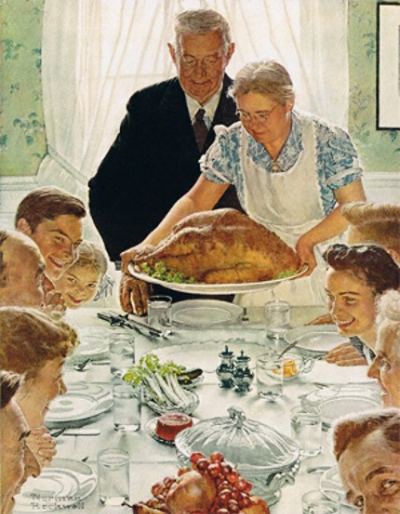Norman Rockwell was the great illustrator of mid-20th Century American complacency. His work is a siren call for the right, most recently expressed by Deborah Solomon in the New York Times:
Norman Rockwell’s cheerful America has lately acquired a startling
relevance both inside and outside the art world, in part because it
symbolizes an era when connectivity did not require a USB cable…
Rockwell’s paintings are easy to recognize. In the years surrounding World War II his covers for The Saturday Evening Post depicted America as a small-town utopia where people are consistently decent and possess great reserves of fellow-feeling. Doctors spend time with patients whether or not they have health insurance. Students cherish their teachers and remember their birthdays. Citizens at town hall meetings stand up and speak their mind without getting booed or shouted down by gun-toting rageaholics.
This is America before the fall, or at least before searing divisions in our government and general population shattered any semblance of national solidarity. Rockwell’s scenes of the small and the local speak to us in the age of the global because they offer a fantasy of civic togetherness that today seems increasingly remote.
America before the fall? Maybe. Eve’s apple came from the tree of knowledge. Our fabled first parents were doing fine as long as they stayed stupid. One bite of reality, and the illusion of a garden dissolved. (As for small-town American utopias, there’s more reality in a page from Babbitt than in a roomful of Rockwell’s.)
To be moved by Rockwell requires a willful narrowing. America in the 1950s was a reasonably decent place if you were middle-class, mentally secure, easily amused and incurious about the lives of others. The Civil Rights Movement and the student rebellions it spawned on university campuses burst those bubbles. A half a century later, the right is still trying to reconstruct them. Despite its efforts, we’ve come a long way since racism, sexism and homophobia were the unchallenged backdrop of American life.
Rockwell painted a celebratory version of ignorance. (If I cannot see you, you cannot be you.) The doctor’s never drunk on a home visit, the priest is not fondling the boys, and the father is never flashing his strap. Above all, women know their place, and black people are content to root around in the shadows.
Image via

Solomon:
It is true that (Rockwell’s) work does not acknowledge social hardships or
injustice. It does not offer a sustained meditation on heartbreak or
death. Yet why should it? Idealization has been a reputable tradition in
art at least since the days when the Greeks put up the Parthenon, and
Rockwell’s work is no more unrealistic than that of countless
art-history legends, like Mondrian, whose geometric compositions
exemplify an ideal of harmony and calm, or Watteau, who invented the
genre of the fête galante.
She’s confusing a search for a root ideal with propaganda. To celebrate a fundamental grace, be it in mathematics or the flounce of a lady’s skirt, is not the same as a cover-up. The first shines, the second rots under its false premises. What Candide concluded about the promises of Pangloss is true of Rockwell’s American Dream: ” It is a mania for saying things are well when one is in hell.” It is an inability to recognize that being born into a favored group is not the same as creating favored circumstances.
Rockwell opens tomorrow at the Smithsonian’s American Art Museum.



What about Rockwell’s “The Problem We All Live With”? Sure a lot of his work is easily pigeonholed into unassuming Americana, but he did handle, with grace and dignity, some of the larger issues. Not all art must be incendiary to be enjoyed.
Hi Jill. The painting to which you refer appeared in 1964, four years after the event and 10 years after Brown v. Board of Education. My point is that he waited until popular opinion had turned against violent acts of overt racism to oppose them himself with an illustration. I’m not saying anything about him as a person. My point concerns what he represents in American culture: the idea that we live in the best of all possible worlds and are the greatest people on earth. I don’t like his paintings as paintings and don’t think their meaning serves us well.
Rockwell had more talent and artistic vision than his AbEx contemporaries in the 1950s. Moreover, his artwork and painting had a more tangible and forceful influence on society of that time. With all the talk of painting being a failure and socially irrelevant, one should look to Rockwell to find a rare time when painting really mattered. Your criticism could just as aptly be applied to AbEx painters of the time. Propaganda and cover ups? Greenberg and the New York School were rife with propaganda which aimed to desperately compensate for the virtual desolation of artistic vision during AbEx’s reign. Do you hate Raphael because he failed to depict Greek slaves in his rhapsodic Classical visions?
That being said, Rockwell’s idealized vision want to make me puke, as if I were watching a Disney show. But there’s no denying his art’s influence on society. I object to your illustrator/painter classification, but I remain a fan of your work. Your post on Chris Jordan was a pure gem.
What isn’t mentioned here is that the Smithsonian exhibit of Rockwell’s work comes from the private collections of George Lucas and Steven Spielberg. Not surprising!
Yes,
Some tedious art was fed to the soldiers and families of the war. Just to make them feel that all their sacrifices were worth something.
Some Kathe Kollwitz would have been cold, but a corrective to that self indulgence.
All Love
David Halberstam said it best: “I suspect that America is not now and never was what it used to be.”